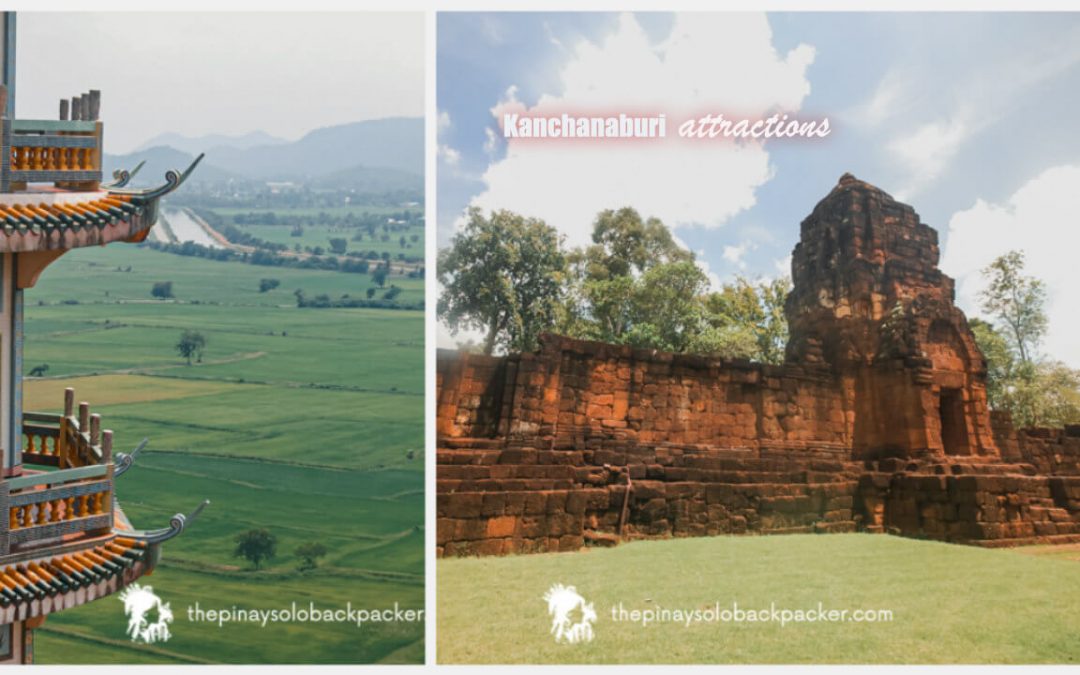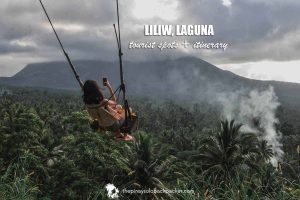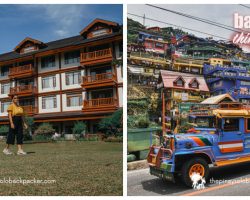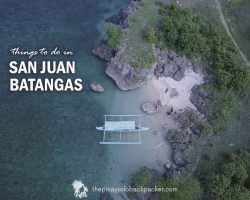Kanchanaburi is the third largest province in Thailand. Just 2.5 hours away by land from Bangkok, it is a tranquil respite from the hustle and bustle of the capital. Kanchanaburi is well-known for its World War II history and the major tourist destinations associated with it, such as the Death Railway, the River Kwai Bridge (made famous by the movie River Kwai Bridge), and Allied War Cemetery. Despite its tragic history and tear-jerking tourist attractions, there’s more to Kanchanaburi for everyone. Over the years, Kanchanaburi has kept its laidback appeal and tourists can enjoy the serene river running through magnificent scenery, hike and take a dip in the turquoise waterfalls, pray at splendid Buddhist temples and go back in time and experience the Siamese lifestyle in a retro-city that recreates the golden era during the reign of King Rama V.
I’ve rounded up the top things to do and see in Kanchanburi here. Feel free to pick whatever interests you. If you have more suggestions, comment down below.
TRAVEL BLOG CONTENTS
KANCHANABURI TOURIST SPOTS
1.DEATH RAILWAY AND BRIDGE ON THE RIVER KWAI
- Entrance Fee: FREE
- Open Hours: 24/7
- How to get to the River Kwai Bridge: Hire a tuk-tuk from your hotel/guesthouse for about ฿40 – ₱64 ($ 1.25,SGD 1.78, MYR 5.46, € 1.15, AUD 1.91, ₩1,555) to take you to the Bridge on the River Kwai. Or rent a bicycle or motorbike from your guesthouse/hotel.
For a hassle-free tour, you may book a Kanchanaburi tour package:
KANCHANBURI PRIVATE TOUR: RESERVE HERE
KANCHANABURI INSTAGRAM TOUR (Day tour from Bangkok): RESERVE HERE

The Death Railway, also called the Thai-Burma Railway is a popular Kanchanaburi attraction with a heartbreaking story. During the World War II when the Japanese already invaded Thailand, they also wanted to seize control of Burma from United Kingdom, so they planned to bring weapons and soldiers to Burma, through a railway connecting Thailand to Burma, thereby forcing hundred thousand British, Dutch, Australians, and Americans soldier prisoners and Southeast Asian laborers to build the said rail. The construction led to hundred thousand death, and many of the prisoners of war (POW) are now buried at the Kanchanburi War Cemetery.
Part of the Death Railway is the River Kwai Bridge, which is featured in the Academy Award-winning movie “The Bridge on the River Kwai”. Though the bridge blown up in the movie is not the bridge in Kanchanaburi, but a bridge built for the movie in Sri Lanka. The actual River Kwai Bridge was built on the Mae Klong River joining the Khwae Noi River somewhere. The former was later renamed Khwae Yai, now quite closer to the name of the bridge.
Note: The River Kwai Bridge can be pretty crowded in the morning once the tourists joining package tours arrive. Best to go here early in the morning or late in the afternoon.
2. JEATHWAR MUSEUM
- Entrance Fee: ฿50 – ₱78 ($1.53, SGD 2, MYR 7, € 1.41, AUD 2.43, ₩1.8K)
- Open Hours: Daily 8:00 AM – 5:00 PM
- How to get to the JEATHWar Museum: Hire a tuk-tuk for about about ฿40 to to take you the JEATH War Museum. Or rent a bicycle or motorbike from your guesthouse/hotel. If coming from the River Kwai Bridge, you can just walk to the museum.

The JEATH War Museum is a stone throw’s away from the River Kwai Bridge, and another famed tourist spot in Kanchanaburi. The name is derived from the first letters of the country involved during the World War II in Kanchanburi – Japan, England, Australia/USA, Thailand, and Holland. It is situated in the grounds of a temple named Wat Chai Chumphon, which is maintained by a monk. It houses war relics, the bomb that didn’t explode, letters and artworks from POWs, their family members and interviews of POWs. One of the galleries here was even designed like attap, bamboo shelter where the prisoners of war lived during the war.

While you are at it, check out the intricately-designed Buddhist Temple beside the JEATHWar Museum. The beautiful wall paintings here are worth checking. I think it is the temple of the monks responsible for maintaining the museum, but outsiders are allowed to visit it.
3.KANCHANBURI WAR CEMETERY AND THAILAND-BURMA RAILWAY CENTRE
- Entrance Fee: Free
- Open Hours: Daily 7:00 AM – 5:00 PM
- How to get to the Kanchanaburi Cemetery: Hire a tuk-tuk to take you there for about ฿40. Or you ca go there by bicycle or motorbike from your guesthouse/hotel.
Kanchanaburi War Cemetery is another well-known Kanchanaburi tourist spot. It is home to the graves of about 7,000 Allied prisoners of war. It is said that out of the 100,000 laborers who died when the Thailand-Burma was built, 16,000 of them were Allied POWs and the rest were Asian and Thai forced laborers.
4.CHUI KAI WAR CEMETERY
- Entrance Fee: Free
- Open Hours: Daily 7:00 AM – 6:00 PM
- How to get to the Chui Kai War Cemetery: Rent a bicycle from your guesthouse/hotel and cycle to the Chui Kai War Cemetery. It is roughly 3 km south of the River Kwai Bridge. Alternatively, you may hire a tuk-tuk to take you there for about ฿40 – ₱64 ($ 1.25,SGD 1.78, MYR 5.46, € 1.15, AUD 1.91, ₩1,555).
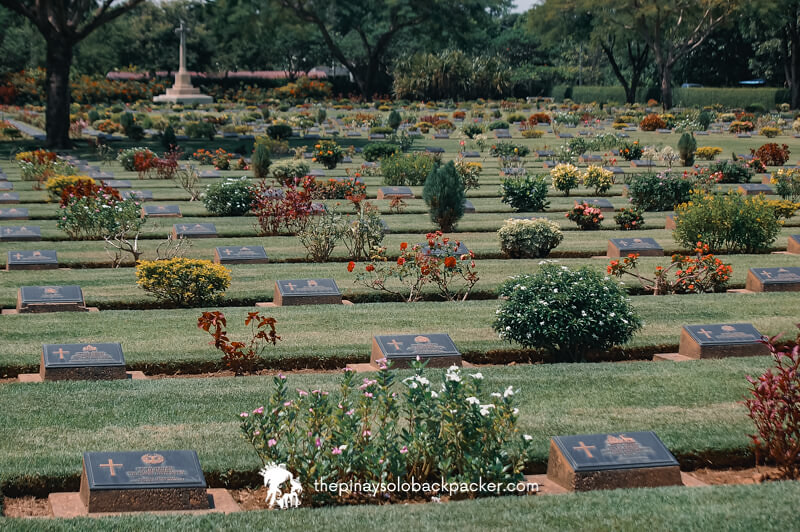
While most tourists in Kanchanburi go to the Kanchanaburi War Cemetery and skip Chui Kai War cemetery, it is an equally important war cemetery in Kanchanaburi situated about 3 km south of the River Kwai Bridge at the bank of Kwai Noi River. I biked here during my trip to Kanchanaburi and it was eerily quiet, makes you wonder how the scene here was like back in days when it was the site of the Allied prisoner-of-war camp during the World War II. During that time, prisoners even built their hospital and church nearby. This beautifully landscaped cemetery is home to the graves of 1,400 Commonwealth soldiers and 300 Dutch soldiers, most of them died at the neighboring hospital.
5.HELLFIRE PASS AND MEMORIAL MUSEUM
- Entrance Fee: Free, donations are welcome.
- Open Hours: Daily 9:00 AM – 4:00 PM
- How to get to the Hellfire Pass: From Kanchanaburi bus station, take a bus to Sangkhlaburi or Thjong Pha Phum. Tell the driver you are getting off at the Hell Fire Pass or Konyu Cutting.
Alternatively, you can flag down the bus at the Kanchanaburi War Cemetery on Road 323. Ordinary bus fare is roughly ฿50 – ₱78 ($1.53, SGD 2, MYR 7, € 1.41, AUD 2.43, ₩1.8K) while aircon buses would cost approximately ฿70 – ₱111 ($ 2.19, SGD 3.12, MYR 9.55, €2 , AUD 3.35, ₩ 2,721). Take note that the last bus trip back to Kanchanaburi is at roughly 4:20 PM, don’t miss it.
Hell Fire Pass, locally known as Konyu Cutting is another popular attraction in Kanchanaburi. While constructing the Death Railway, there was a large solid rock on Tenassirim Hills that was extremely difficult to cut. Because of this, thousands of prisoners had to work about 16 – 18 hours a day to cut it. It earned its nickname “hellfire” because of the glow of the burning torches that cast spooky shadows of the Japanese soldiers and the prisoners’ faces that seem to resemble an inferno. There’s a free audio guide that visitors can use here, discussing the history, details, and personal accounts from survivors. The museum here us co-sponsored by the Australian Government and the Royal Thai Armed Forces to commemorate the death of thousands of allied prisoners, mostly Dutch, British, Australians, and Americans, and forced Southeast Asian laborers – mostly Malay, Tamil, and Thais. There are 2 walking trails at the Hellfire Pass; one is the easier route called Walk 1- about 1 km roundtrip trail, while the other is the more difficult trail dubbed as Walk 2 that about 5 km with steep climbs all the way to Hintok Cutting.
6.THAM KRASE VIADUCT AND THAM KRASE CAVE TEMPLE
- Entrance Fee: Free
- Open Hours: 24/7
- How to get to Tham Krase Bridge (Wampo Viaduct) and Tham Krase Cave Temple : From Kanchanaburi or Tha Kilen Station, take a train to Nam Tok Sa Yok Noi Station. Get off at Tham Krase Station. Walk to the Wampo Viaduct.
If you still have more time, you can visit the Tham Krase Viaduct (also called Wampo Viaduct) and Tham Krasae Cave Temple from Tha Kilen Station before or right after your visit Muang Singh Historical Park, or after visiting the Death Railway Bridge in Kanchanburi. But make sure to check the last train schedule back to Kanchanburi, unless you are taking a taxi.
The Tham Kraase Bridge or Wampo Viaduct is the abandoned part of the Death Railway Station, another famous tourist attraction in Kanchanaburi. This wooden bridge offers a spectacular view of the river below surrounded by lush jungle. Nearby is a Buddhist temple inside a natural cave , commonly called Tham Krasae Cave Temple. Visitors can visit the cave temple to commemorate the death of the allied soldiers and forced laborers who died during the construction of the Death Railway under the Japanese regime. Inside the cave temple is a massive sitting golden Buddha.
7.CAVE TEMPLE
A climb up the hill leads to the narrow entrance of Lawa cave, a large cave with several chambers and numerous stalactites and stalagmites. Lawa cave is located on the Khwae Noi river (river Kwai). To get there, charter a boat at Pak Saeng pier. The trip takes between 45 minutes and 1 hour.
8.WAT THAM SUA + WAT THAN KAO NOI
- Open Hours: Monday to Friday 8:30 AM – 4:30 PM, Saturday and Sunday 8:00 AM – 4:30 PM
- *Entrance Fee: Free, cable car going up is ฿20 – ₱32 ($0.63, SGD 0.89, MYR 2.73, € 0.57, AUD 0.96, ₩K 777)
- How to get to Wat Tham Sua: You can join group tours or hire a tuk-tuk to take you to Wat Tham Sua. Alternatively, from Kanchanaburi, you can take a bus to Ratchaburi. Alight at the bus stop fronting Tha Mueang Hospital. From there, you can hire a motor taxi to take you to Wat Tham Sua.

If you’ve had your fill of World War II spots in Kanchanaburi, you can visit the temples sprinkled around the province. My personal favorites are Wat Tham Sua (Thai-styled temple) and Wat Than Kao Noi (Chinese-inspired temple), not only because of their elaborate architecture, but also because of the surrounding scenery. The temples are located on top of a limestone hill near the Mae Khlong River. It is definitely one of the most beautiful and Instagram-worthy temples in Thailand.
*I took a bus to the nearest bus, which is still far by the way. From there, I hired a motorcycle (with driver) to take me to Wat Tham Sua and Wat Than Kao Noi. Fortunately, the driver understood me and took me there. I can’t remember how much he charged me, but I think it’s more or less ฿100 one-way. I didn’t ask him to wait for me as I knew I will take time roaming around the temple. There are motorcycles awaiting visitors at the temple anyway since many locals come here to pray.
As I entered the temple gates, I took an old-looking cable car going up for is ฿20 – ₱32 ($0.63, SGD 0.89, MYR 2.73, € 0.57, AUD 0.96, ₩K 777). It looks dodgy, but it took me right on top safely. But if you want to climb the 157 steps stairs (if you still have energy), you can also do so. As I reached the summit, the giant golden Buddha crowning the temples dwarfed me. It is standing at 18 meter high and as I looked closer, it is actually made of golden mosaic. I was lucky because there weren’t much tourist when I visited Wat Tham Sua and and Wat Than Kao Noi. I even chanced upon some young monks wearing their tangerine robes happily snapping photos at the temple. The gigantic Buddha is surrounded by intricately-designed stupas. The biggest stupa contains murals that are mostly about the war with Burma and the Buddha images in different postures.

Wat Tham Suea (also Wat Tham Sua) is said to be called Tiger Temple, not to be confused with the infamous Tiger Temple in Kanchanaburi with actual tigers that was raided and closed to the public. I did notice some tiger statues flanking the base of the hill next to the cable car and there’s also near the stupa beside the beside the giant Buddha. But the temple was called such because there’s a cavern here where tigers used to live, but now, only a small tiger shrine can be seen inside the cave.
Beside Wat Tham Suea is the equally beautiful temple named What Than Kao Noi. It reminds me of Chinese temples I visited before. Wat Than Kao Noi is a Buddhist temple flanked with intricate tiled Buddha images and bells. Each floor contains Buddha statues. Make sure to climb this temple and soak in the stunning view of the green farmland surrounding the temples below. It offers the best view of Wat Tham Suea. I spent a few hours just sitting and roaming around this temple because I can’t get enough of it. It is so dreamlike that I don’t want to leave! My only regret is I didn’t I have a tour guide to explain to me the history and the details of these temples, I would love to learn more about it.
9.ELEPHANTS WORLD KANCHANABURI
From an estimated 100,000 elephants in Thailand in the 19th century, there are only about 3,000 domestic and 2,000 elephants in the wild now, according to Elephants World Kanchanburi. The elephants in Thailand were used to carry logs for the logging industry back in the days. But after a devastating flood in 1989, logging activity was totally banned by the government to prevent further deforestation. Since then, the elephant owners needed to find other ways to finance the food and upkeep of the elephant. A veterinarian – Dr.Samart and his wife Khun Fon founded Elephants World in Kanchanburi in 2008. They provided a small home for the injured and elderly elephants in the province and started a fund-raising activity for the upkeep the said elephants. They became known and eventually decided add to the conservation program an eco-tourism activity to self- finance the growing community of domestic elephants, mahouts, and staff.
Today, Elephants World is home to over 30 domestic elephants that they care for. They offer 3 kinds of programs – the Day Program, the Overnight Program, and the Forest Program so visitors can experience up-close and personal encounters with these elephants. It is one of the top things to do in Kanchanaburi.
ELEPHANTS WORLD KANCHANABURI (Day Program) : RESERVE HERE
9.ERAWAN NATIONAL PARK
- Entrance Fee: Adult (foreigner) ฿300 – ₱487 ($10, SGD 13 , MYR 41, €9, AUD 14, ₩K 12K), child (foreigner) ฿200 – ₱324 ($6.45, SGD 9, MYR 28, €6, AUD 9.45, ₩8K)Adult (local) ฿100 – ₱159 ($3, SGD 4.46, MYR 13, € 3, AUD 4.79, ₩K 3.8k), Child (local) ฿50 – ₱79 ($ 1.56, SGD 2.23, MYR 7, €1.44 , AUD 2.39, ₩K 1.9k),
- Parking fee: Car ฿30 – ₱48 ($ 0.94, SGD 1.34 , MYR4 , € 0.86, AUD0.96 , ₩1,166), motorbike ฿20 – ₱32 ($0.63, SGD 0.89, MYR 2.73, € 0.57, AUD 0.96, ₩K 777)
- Open Hours: Daily, Park Gate 8:00 AM – 4:00 PM, waterfall 1- 3 8:30 AM – 5:00 PM, waterfall 4-7 8:30 AM – 4:00 PM
- *How to get to the Erawan Waterfalls: Take the bus to Erawan National Park from Kanchanaburi Bus Station that leaves every hour from 8:00 AM to 5:30 PM. Take note that the last bus from Erawan to Kanchanaburi leaves at 5:00 PM. Don’t miss it. Bus fare is around ฿40 – ₱64 ($ 1.25,SGD 1.78, MYR 5.46, € 1.15, AUD 1.91, ₩1,555) per person, one way. Travel time is roughly 1.5 hours.
Note: If you are bringing water bottle to Erawan Falls Level 2 and up, you need to pay a deposit of ฿20 to the park rangers, which you will get back once you get down and bring back your water bottle. This is to ensure that you didn’t leave your trash at the park. Drinking of liquor is prohibited at Erawan Park. Make sure to read the rules and reminders at the park to avoid accidents and hefty penalty.
One of the main reasons why I visited Kanchanaburi is to see the most famous tourist destination here – the 7-tiered Erawan Falls, located inside the confines of the Erawan National Park on Tenassirim Hills. The name was coined from “erawan”, the 3-headed white elephant in Hindu mythology, which is said to resemble the top-tier of Erawan Falls.
Erawan Waterfalls is composed of 7 levels, which are not that hard to reach. The 1st level of Erawan Falls is called Hlai Khuen Rung, about 500 meters from the beginning of the trail. It has picturesque teal-colored water that flows into the pool with little fishes that can nibble your feet’s dead skin like those found on fish spa. The place is usually crammed though as this spot is a popular picnic place for the locals. There are also food stalls here, so you don’t have to worry about packed lunch. You can indulge on local foods here like rice, grilled chicken, somtam, etc.

Wang Macha, the 2nd level of Erawan Waterfalls is another Instagram-worthy attraction in Kanchanaburi. The sapphire-colored water pouring into tranquil natural pools and rock formations makes for a perfect place for swimming. There are comfort rooms, shower rooms, and changing rooms here.
Meanwhile, the 3rd level of Erawan Falls called Pha Namtok plunges into a massive natural pool clad by towering trees and greeneries. The 4th level of Erawan Falls called Oke Nang Peesu is bit farther, but it’s another crowd pleaser due to its natural waterpark, where visitors can slide and bathe in the refreshing artic-colored water.
Buea Mai Long, the 5th level of Erawan Falls is another postcard-worthy waterfalls boasting of mint-colored water plunging into gorgeous travertine pools. It’s a good place for swimming due to the refreshing calm water surrounded by jungle. It reminds me of a part of Aguinid Waterfalls in Cebu, Philippines.
The 6th level of Erawan Waterfalls called Dong Prucsa is quite difficult to reach compared to the other levels. Needless to say, it’s worth the adventure. The falls here reminds me again of one of the falls in Cebu, the water tumbling down massive rock formations before flowing into the pool. The Phu Pha Erawan is the 7th level of Erawan Waterfalls and is shaped like “erawan” – the 3-tiered white elephant in the Hindu mythology.
10.MUEANG SINGH HISTORICAL PARK
- Entrance Fee: ฿100 – ₱159 ($3, SGD 4.46, MYR 13, € 3, AUD 4.79, ₩K 3.8k)
- Parking fee: Car ฿50 – ₱79 ($ 1.56, SGD 2.23, MYR 7, €1.44 , AUD 2.39, ₩K 1.9k), Motorcycle – ฿20 – ₱32 ($0.63, SGD 0.89, MYR 2.73, € 0.57, AUD 0.96, ₩K 777),
- Open Hours: Daily 8:00 AM – 5:00 PM
- How to get to the Muang Sing Historical Park: Take a train ( ordinary train #257 or #259) from Kanchanburi to Tha Kilen or Nam Tok Sa Yok Noi. Get off at Tha Kilen Station, travel time is about 1 hour. Then at Kilen Station, take a tuktuk to Mueang Singh Historical Park. The train departs around 10:35 AM and 4:26 PM. The train going back to Kanchanaburi leaves at 6:14 AM and 1:54 PM. Make sure not to miss the last trip going back to Kanchanaburi at 1:54 PM, be at the station at least 30 minutes before the scheduled departure. If you miss it, your next option is to take a taxi to Kanchanaburi. Foreigners are typically charged a higher fare of ฿100 – ₱159 ($3, SGD 4.46, MYR 13, € 3, AUD 4.79, ₩K 3.8k) per person one-way.

This is another must-see Kachanaburi tourist attraction. When the Khmers abandoned Kanchanaburi, they left behind several Bayon-style temples (similar to the temples in Cambodia) dotting the landscape of Sai Yok District on the western side of the province, near the Myanmar and Yunnan, China border. Some of them can now be visited by tourists traveling to Kanchanaburi at the stunning Mueang Singh Historical Park, fringed by lush jungle. Built during the rule of King Jayavarman during the thriving era of Khmer Empire, the tranquil historical park is crowned by the main shrine here – Prasat Muang Singh Temple, proudly standing on the midst of the estate. The age-old temples at Mueang Singh are mostly made of laterite, which explains their marmalade shade. The Buddhist temples here are dedicated to the Hindu God Shiva and the property is also believed to have served as a military post and transit of trade along the Mae Nam Khwae Noi.

Adjacent to the nearby river is the prehistoric burial site with pottery, jewelry, and 2 human skeletons on display, which is said to date back 2,000 years ago before Mueang Singh was founded. Some locals also sell goods here.
11.MALLIKA CITY
- Open Hours: 9:00 AM – 7:00 PM
- Entrance Fee:
| ADULT | CHILD | |
| Admission Fee | ฿250 – ₱397 | ฿100 – ₱158 |
| Admission Fee + Thai Costume | ฿400 – ₱635 | ฿300- ₱477 |
| Admission Fee + Lunch | ฿500 – ₱795 | ฿250 – ₱397 |
| Admission Fee + Thai Costume + Lunch | ฿650 – ₱1,033 | ฿450 – ₱715 |
| Admission Fee + Thai Dance Show + Dinner | ฿700 – ₱1,112 | ฿350 – ₱556 |
| Admission Fee + Thai Dance Show + Dinner + Thai Costume | ฿900 – ₱1,430 | ฿500 – ₱794 |
- MALLIKA KANCHANABURI TICKET: DISCOUNTED TICKET HERE
Travel back in time at the sprawling Mallika City in Kanchanaburi, a retro-city of the bygone Siamese lifestyle in the Chao Phraya River basin. The name Mallika in Thai means jasmine, but there’s also a river source in Burmese Ayeyarwady River named such. When Mallika was designed by Associate Professor Chatri Prakitnonthakan of Silakorn University, he made up a story of Mali (jasmine), a farmer residing in a Reauan Dieow, house in the countryside. Mallika City recreates the Golden Age era in Thailand during the reign of King Chulalungkorn (Rama V) from 1873 to1910 A.D.,who abolished slavery in the country. At the end of his rule, Bangkok became an international port, filled with people from different indigenous groups, cultures and customs eventually influencing the Siamese way of life.
At Mallika City, you can rent and wear Thai traditional clothes as you tour around, and you need to change your Thai Baht to ancient money called Satang at the ticket office, which you can use to buy food, drinks and handmade local crafts at the village.
Mallika City tourist spots includes (1.)Saphan Han, the bridge that can be moved to allow boats to pass through and believed to be King Rama’s favorite bridge, the (2.) City Tower, originally a prison tower but now used as an observation deck of Mallika City, (3.) the Ancient Market Zone (Prange Nara, Prange Phuthorn, and Prange Sappasart neighborhood) where various ancients products are on display such as candles, perfumes, dessert, etc. and visitors are highly encouraged to participate in making these products (4.) Thai traditional houses and structures like Reuan Diew – the house for commoner, Reuan Khaha Bodi – the house for the rich and ruling class, Reun Pae Floating House – shophouse or café by the river banks, and Reuan Hmoo – used by the rich people as a visitor reception area, this is where tourists can watch Thai traditional dance and show during dinner, (5.) Jasmine Garden – a garden sprinkled with various kinds of jasmine plants, which inspired the named Mallika.
12.TREE TOP ADVENTURES KANACHANABURI
TREE TOP ADVENTURE TICKET: DISCOUNTED HERE
For adrenaline junkies, Kanchanaburi has something in-store for you – Tree Top Adventures is another popular tourist spot in Kanchanaburi. Gear up for the adventure of a lifetime at this sprawling nature park with 40 game stations packed with extreme and exciting adventures to try – from zip-lines and sky bikes to swings and ladders in the forest! You can even rest on a giant hammock suspended high above the ground!
HOW TO GET TO KANCHANABURI

BANGKOK TO KANCHANABURI BY TRAIN
There’s a historic train route along the Bangkok Noi-Nam Tok rail line that runs from Thonburi Station in Bangkok to Kanchanaburi. Fare is roughly ฿100 – ₱159 ($3, SGD 4.46, MYR 13, € 3, AUD 4.79, ₩K 3.8k).
BANGKOK TO KANCHANABURI BY BUS
From either the South Bus Terminal (Sai Tai Mai) and the North Bus Terminal (Mo Chit) in Bangkok, you can take a bus to Kanchanaburi. Travel time is roughly 2.5 hours and bus fare starts at ฿120 – ₱191 ($ 3.75, SGD 5, MYR 16, € 3.44 , AUD 6, ₩K 4.6k) per person one-way.
BUS TICKET: RESERVE HERE
BANGKOK TO KANCHANABURI BY MINIVAN
There are minivans to Kanchanaburi from Victory Monument in Bangkok and Khao San Road. Fare starts at ฿150 – ₱240 ($5, SGD 7, MYR 21, € 4, AUD 7, ₩K 5,833k) per person and transit time is approximately 2 hours and 30 minutes.
BUS TICKET: RESERVE HERE
BANGKOK TO KANCHANABURI BY PRIVATE CAR OR VAN
A hassle-free way to visit Kanchanaburi from Bangkok is by private car or van, you can rent a car or van that is good for 3-10 persons and divide the cost.
CAR RENTAL: BOOK HERE
GETTING AROUND KANCHANABURI
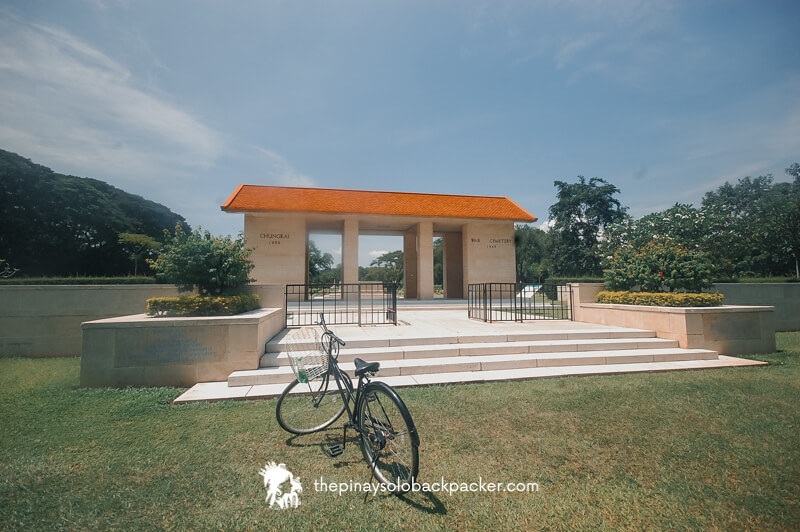
BY TOUR PACKAGE
A hassle-free way to tour Kanchanaburi is by joining group tours or booking a private tour. This will help you maximize your time and ensure that you have a tour guide to explain the details and history of each tourist attraction you are visiting.
KANCHANABURI INSTAGRAM TOUR (DAY TOUR FROM BANGKOK): RESERVE HERE
KANCHANABURI HIGHLIGHTS (PRIVATE TOUR): RESERVE HERE
BY TUKTUK
Short rides from the hotel to the River Kwai Bridge will cost around ฿40 – ₱64 ($ 1.25,SGD 1.78, MYR 5.46, € 1.15, AUD 1.91, ₩1,555) per person.
BY BIKE
Bike rentals starts at ฿50 – ₱79 ($ 1.56, SGD 2.23, MYR 7, €1.44 , AUD 2.39, ₩K 1.9k per day
BY MOTORBIKE
Motorcycle can be rented for about ฿200 – ₱79 ($ 1.56, SGD 2.23, MYR 7, €1.44 , AUD 2.39, ₩K 1.9k per day.
BY CAR RENTAL
A convenient way to tour Kanchanaburi is by car, you can hire car for a day to reach the tourist spots outside Kanchanaburi center.
CAR RENTAL: RESERVE HERE
KANCHANABURI AND THAILAND POCKET WI-FI (Bangkok Airport Pick up): RESERVE HERE
WHERE TO STAY IN KANCHANABURI
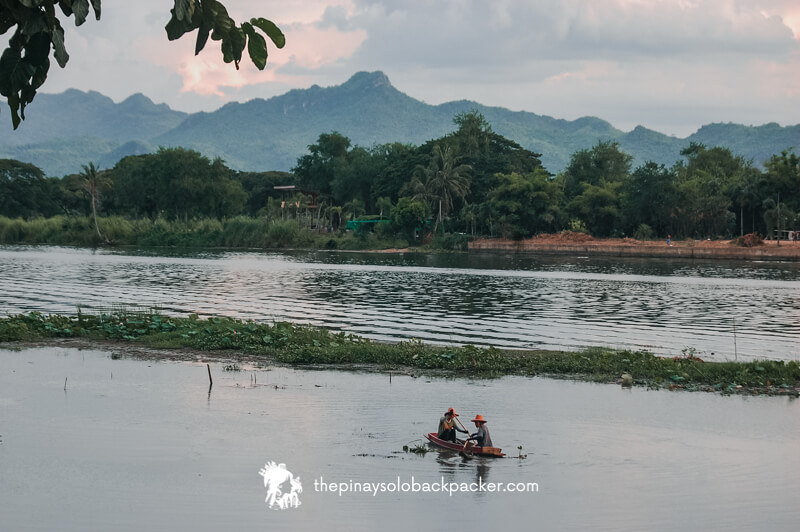
- RIVER KWAI HOTEL
Location: River Kwai, Kanchanaburi
- RIVER KWAI BRIDGE RESORT
Location: River Kwai, Kanchanaburi
- SKY RESORT KANCHANABURI
Location: River Kwai, Kanchanaburi
- BAMBOO HOUSE KANCHANABURI
Location: River Kwai, Kanchanaburi

ALSO READ:
KANCHANABURI TRAVEL GUIDE
SUKHOTHAI TRAVEL GUIDE
BANGKOK TRAVEL GUIDE
BANGKOK ITINERARIES
HUA HIN THINGS TO DO
SAMUT SONGKHRAM THINGS TO DO

